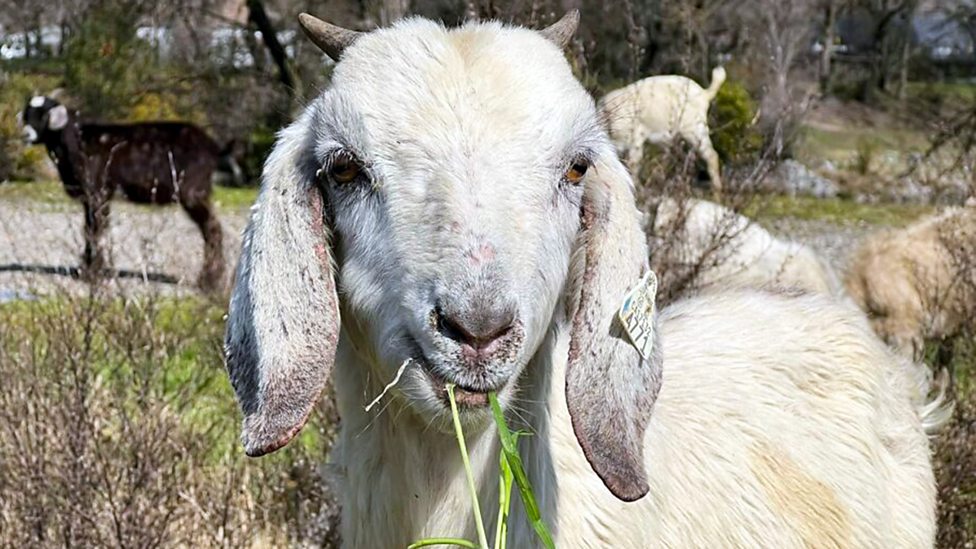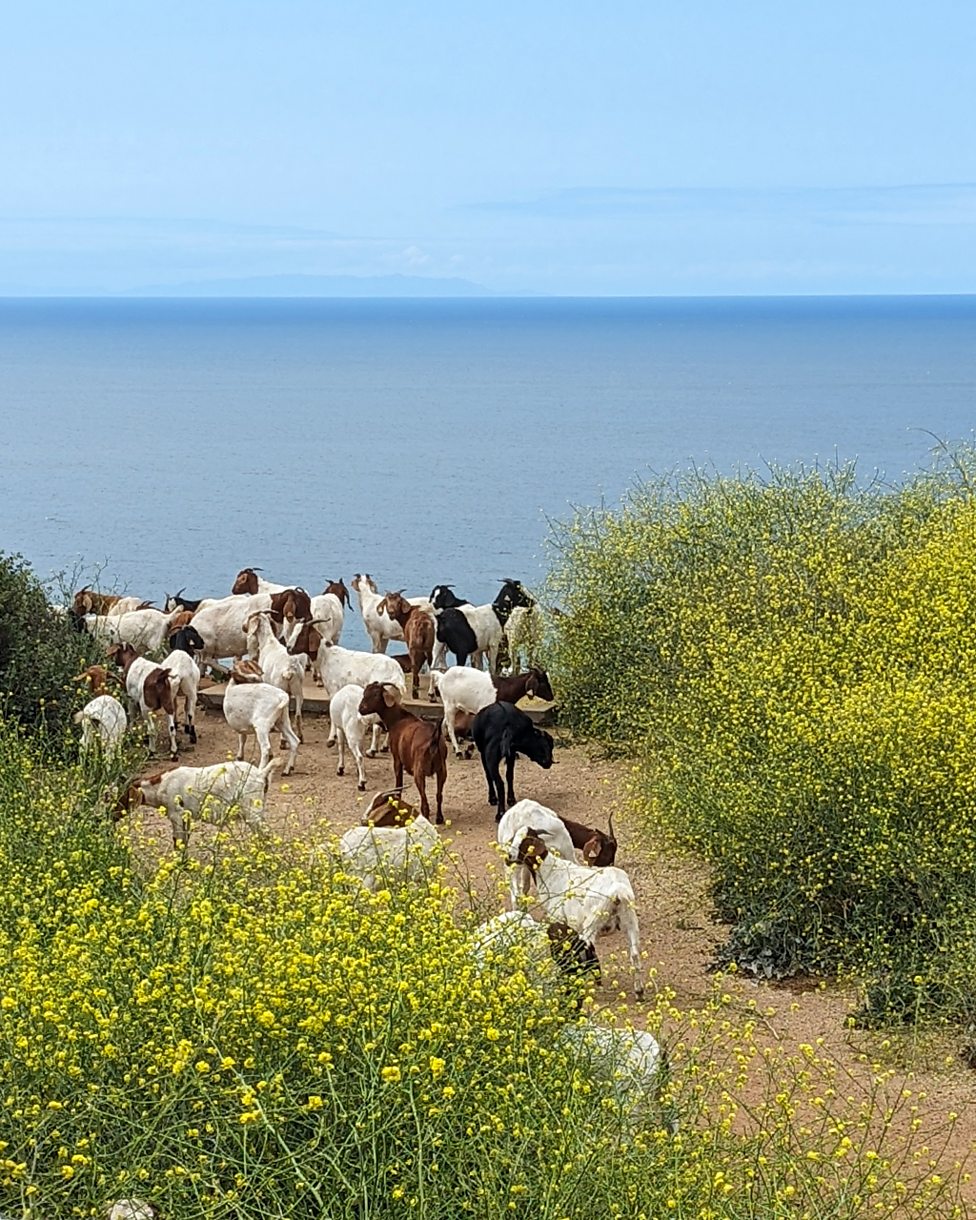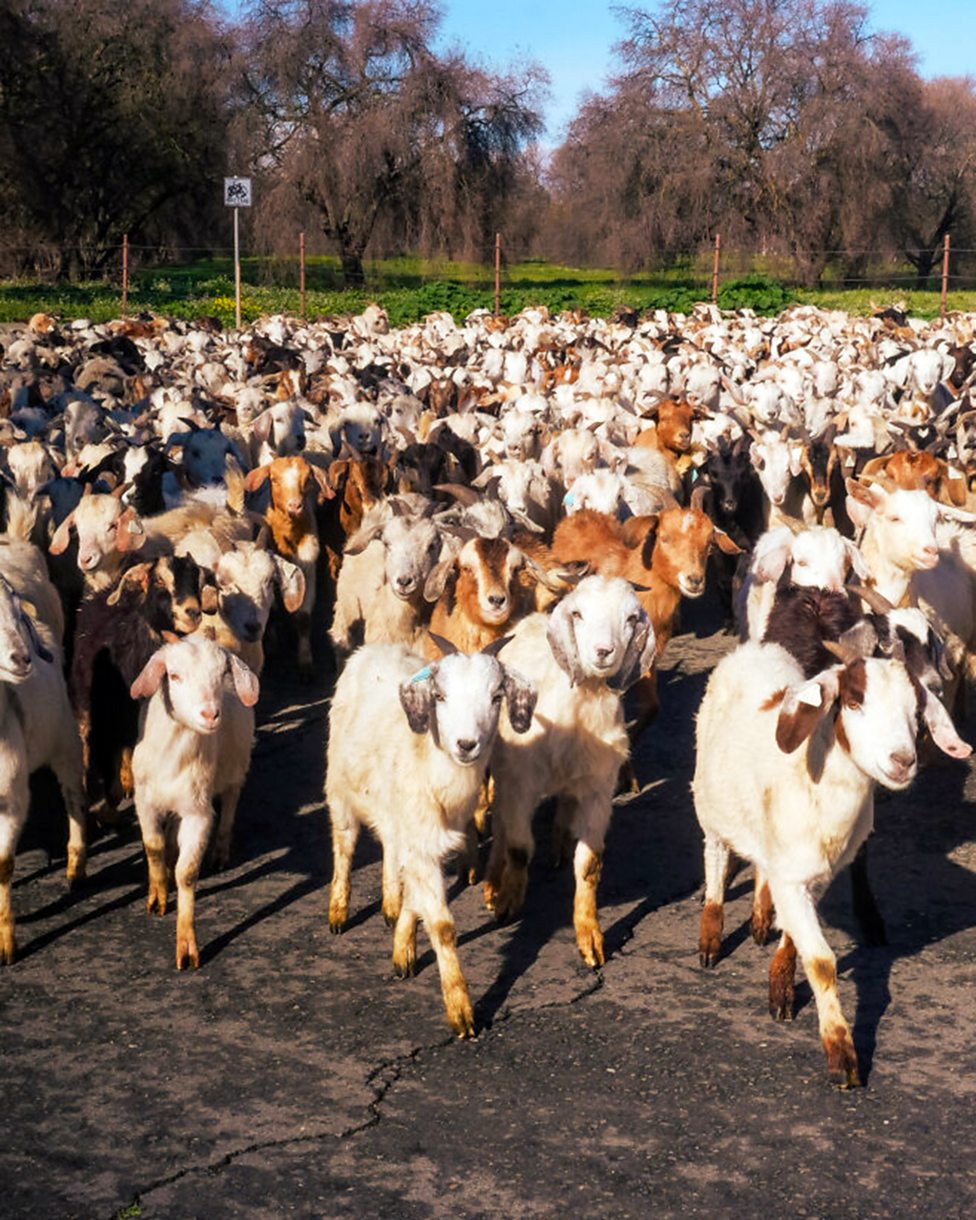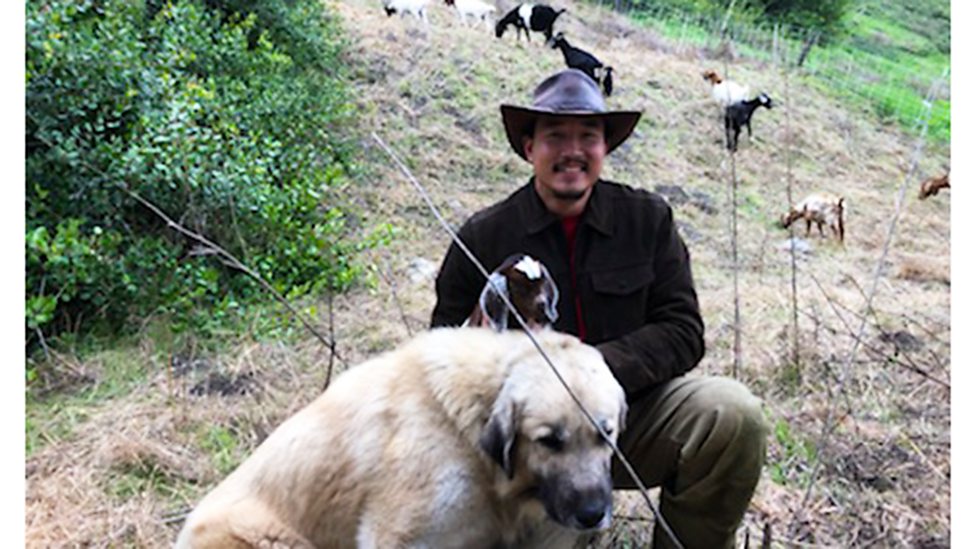Goats as Firemen in California, They were Firemen Before The Firemen Depts.
 |
| I'm looking at U |
Grazing goats are becoming a common sight in Los Angeles – can this ancient solution to wildfires really prevent ever bigger, fiercer blazes?
It's a typical Los Angeles scene: the Pacific Ocean sparkling under a crystal-clear, bright blue sky, with miles of golden sandy beaches stretching as far as the eye can see. There's also a herd of goats precariously perched on a clifftop, enjoying the multimillion-dollar view.
These aren't just any goats, though – they're California's new secret weapon in the fight against wildfires, and they're being put out to graze across the state.
"The reception is overwhelmingly positive wherever we go," says goat herder Michael Choi. "It's a win-win scenario as far as I can tell."
Choi runs Fire Grazers Inc., a family business that leases goats to city agencies, schools, and private clients to clear brush from hillsides and terrain that's hard to access. The company has 700 goats, and they recently had to expand their herd to keep up with demand.
 |
Lucy Sherriff
California has been at the epicentre of battling wildfires, which have become more frequent, more destructive, and larger, since 1980. In 2021, California faced "unprecedented" fire conditions, according to CalFire (California Department of Forestry and Fire Protection, the state's fire agency), with one fire alone burning more than 960,000 acres (3,885 sq km). Well-timed rainfall can bring some relief, even as the wider situation remains severe. The wildfire season in 2022 was described as a "mild" for the state – more than 300,000 acres (1,214 sq km) burned compared to the five-year average of 2.3 million acres (9,307 sq km). This year, August was cooler and wetter than average in California. Still, more than a quarter of a million acres have burned, and four people have died.
Factors such as hotter, drier conditions due to climate change are key drivers in increasing the risk and severity of the fires, research shows. But there are also studies suggesting that land management can play an important role, as the build-up of dead trees and dry shrubs creates dangerous fuel that can lead to big, severe fires. Land managers traditionally relied on herbicide and manual labour to thin out brush and reduce dry fuel, but agencies and city officials are also trying out other, potentially more sustainable and cost-effective methods – such as goats.
"Goats are especially useful in places like California and the Mediterranean because of the shrubs – goats are very well equipped for that, they have the right mouths," says Karen Launchbaugh, an ecology professor at the University of Idaho who has conducted multiple studies on sheep, goat and cattle grazing. "They're just designed to eat shrubs."
Launchbaugh says she's seeing more city officials and land managers open to trying goats as a new method of mitigating wildfire risk. "I'm excited because when we started researching this, we didn't know where it was going to go. And now there's enough work for people making a living out of being a grazer – and cities and counties are willing to pay for it because they know it makes a difference."
Goats have insatiable appetites, and devour weeds, bushes, low hanging leaves, and dry brush – all of which are fuel for fires. California's wildfire preparedness guidelines instruct residents to remove all dead vegetation, and mow grass down to four inches (10cm) – everything a goat would do naturally, enthusiastically, and without being reminded. Goats also are unperturbed grazing away in triple digit heat [100F/37.7C and above], and have no problem scaling steep mountainsides which can be difficult to access for labourers.
"Goats are natural mountaineers. They can climb up steep hills with no problem, they get all into the nooks and crannies that would normally be very difficult for people, and they eat almost everything," says Choi.
 |
City of West Sacramento
In Glendale, a city within Los Angeles County, 300 goats are hard at work on the Verdugo Mountain ridges, clearing 14 acres (5.6 hectares) over the span of two weeks. The city is classed as a "very high fire hazard" zone. To reduce the risk, Patty Mundo, Glendale Fire Department's vegetation management inspector, has used Choi's goats since 2018. Their purpose is to create a buffer zone between homes and open spaces of land so if there is a fire, it would slow the flames down – or hopefully stop them completely. Having a buffer zone helps protect homes from fire, crucial in a state where more than 60,000 communities are at risk from wildfires.
In West Sacramento, goat herds have been used since 2013 in fire prevention measures as a "creative and environmentally sustainable method" to better manage fire fuel reduction, says Jason Puopolo, parks operations superintendent for the city. The goats come to town twice a year – once in the spring to clear growth from the winter rains, and once in the autumn to clear tinder dry brush. Last season the city paid $150,000 (£120,000) to goat herding company Western Grazers to work the land.
"The greatest benefit [we've seen] is reducing the risk and potential workplace injuries in difficult to access areas," Puopolo says. "We have levees that are sloped and forested heavily in places and they can put staff at a high risk of injuring themselves even just with a slip or fall."
The goats' hard work has paid off so much that the city's fire service credited the herds with helping stop the flames during a fire in 2022, saving a housing complex. "Our fire chief said if the goats had not made a previous pass in that field, the fire could have been a lot worse," Puopolo continues. "Because the goats had recently nibbled down the brush in the area to four inches (10cm) high, fire crews were able to get a jump on the flames and save the condos."
Goats are also useful when it comes to controlling invasive species, such as non-native black mustard plants. When the seed comes out the other end of the goat, it's nonviable, meaning it doesn't grow again – unlike when other animals digest seeds.
Using goats to clear land is a centuries-old practice in European countries such as Italy, Greece, and Spain. A study into how effective goat grazing in the Mediterranean is in preventing fires found it is "probably the most ecologically sound technique for creating discontinuities in fuels, mainly at the shrubby layer, and disrupting fuel ladders." Although the practice hasn't been around for quite so long in California, experiments to enrol the ungulates in fire management have been taking place for more than a decade.
In 2013, the US Forest Service (USFS) experimented using 1,400 goats in a 100-acre (40-hectare) forest-thinning project in Cleveland National Forest, Southern California. The aim was to clear a 300ft (91.4m) buffer between nearby communities and the forest. "To clear a fuel break normally means lots of human power and machinery, including chainsaws, hand tools and safely burning piles of brush," said Joan Friedlander, district ranger for the area. The goats, which USFS says cost between $400-500 (£326-408) per acre, compared to around $1,200-1,500 (£980-1,224) per acre when using manpower, attracted a large amount of community support. The forest's managers established a plan to monitor pre and post-treatment plots so the effective of the goats could be evaluated over time and compared to traditional methods used in the area.
A study on the forest's use of goats found the animals had a "significant impact" reducing plant cover – 87% reduction in cover, and a 92% reduction in height. Goats don't have to be the only way to manage the landscape, but using wildlife in this way "should be part of the toolbox when we're fighting against wildfires", adds Launchbaugh.
 |
Michael Choi
Some fire departments are even buying their own animals. "They eat all the grasses and brush down to the ground level, which obviously helps us with mitigating wildfires in the area," says Chris Nelson, assistant chief with the San Manuel Fire Department, who have their own herd of 300 goats. The goats work through two to five acres at a time, before they're moved onto the next patch. At the end of summer, fire officials will trim down any brush the goats left behind.
The state's fire agency CalFire has handed out a number of grants to cities to fund trials of goat grazing. "Many of our recipients found grazing to be an effective tool, especially in the maintenance of fuel reduction projects," says Kara Garrett, a governmental program analyst at CalFire. "Lawn mowers, weed-eaters, chain saws, tractors, and trimmers can all spark a wildland fire if used during the wrong time of year, and with work still left to be done across California, the grazing goats are a safe alternative to help maintain vegetation."
While Puopolo would "absolutely" recommend using goats to any other city, and frequently speaks with communities across the country about their benefit, he also cautions that they're not always the best solution. "Using them comes at a cost, they don't benefit every situation financially, especially in flat open areas where a mower can do the work much faster and at a lower cost."
Launchbaugh also highlights the year-round cost, pointing out that goats can't simply be stored in a shed until they're needed the following season. "You need the travel infrastructure to cart them around, and it's a skill to know how to manage animals, so you need an experienced herder," she says.
The type of terrain is also something that needs to be factored in. In the Great Basin, where Launchbaugh has conducted most of her research, the main problem is long grass, and so they use cows instead of goats, since cows are more efficient at keeping grass short. Goats can't differentiate between native and non-native species either, and they'll eat desirable, native shrubs as well as invasive, non-native species.
For those who love the sight of goats chomping their way through the California brush, however, the benefits go beyond cost and impact.
"This is a conscious effort to bring things back to their natural way of being," says Choi. "And besides, they're far more entertaining."
Comments